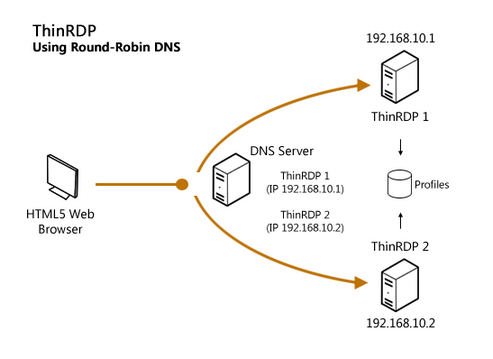In this case, the DNS will be in charge of distributing load to a number of ThinRDP Servers. Each ThinRDP Server needs to be configured in such way that they can share the profiles database.
The difference between these technique and the ThinRDP Load Balancing is that the Round-Robin DNS does consider the workload of each ThinRDP Server in order to assign a new connection to be processed. This method does not make a failover control, because the DNS Server does not know whether the ThinRDP Server is active and receiving requests. If a Server falls down, the DNS Server will keep redirecting web requests to it.
The image below shows how the "Round-Robin DNS" architecture works:

Setting up the architecture:
1. Install ThinRDP on each one of the machines that will act as ThinRDP Servers.
2. Set the Profiles "Database Path" of all Servers to the same database file. On the bottom of the Access Profiles tab, there is a field called "Database Path".
3. Configure all the settings (General, Security, Access Profiles1, Folders, Permissions and License)2.
4. Configure your DNS Server, associating the domain name with all the existing ThinRDP Servers IP's.
5. Make sure all the ThinRDP Servers are public to the Web Browsers that will access ThinRDP.
Important observations:
1. On the step 3, the Access Profiles settings have to be done only in one of the existing servers. The other servers should be pointing to the same database file, so that once the profiles are configured in one ThinRDP Server, they will work evenly for all of them.
2. It is recommended that all ThinRDP Servers have the same "Authentication Method", "Temporary and Shared Folders Settings". That way, the different ThinRDP Servers will establish connections that same way and keep all the Folders data centralized.